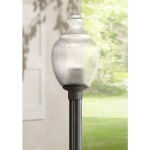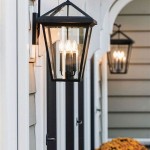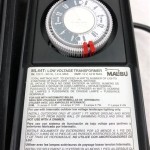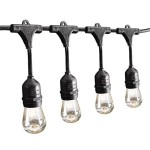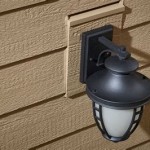Enhancing Your Pool Cage with Outdoor Lighting
Pool cages, also known as screen enclosures, are common features in warmer climates, providing a barrier against insects, debris, and the elements. While offering practical benefits, these structures can also be enhanced aesthetically and functionally with the addition of outdoor lighting. Well-planned lighting not only extends the usability of the pool area into the evening hours but also improves safety and creates a more inviting ambiance.
The integration of outdoor lighting into a pool cage project requires careful consideration of several factors, including the type of lighting fixtures, their placement, power source options, and adherence to electrical codes and safety regulations. The goal is to achieve a balanced lighting scheme that provides sufficient illumination for activities while maintaining a visually appealing and comfortable environment.
Key Considerations for Pool Cage Lighting
Before embarking on a pool cage lighting project, it is essential to address several fundamental considerations that will influence the design and execution. These include understanding the specific needs of the pool area, selecting appropriate fixtures, and planning for proper installation and maintenance.
Firstly, the intended use of the pool area after dark needs to be defined. Is the goal primarily to illuminate the pool itself for nighttime swimming, or is it to create a relaxed outdoor living space for dining and socializing? The answer will dictate the required light levels and the types of fixtures that are most suitable. For example, if the pool is used for swimming at night, underwater lighting or strategically placed spotlights around the perimeter of the pool may be necessary. If the area is mainly for relaxation, softer, ambient lighting sources may be more appropriate.
Secondly, the architectural style of the pool cage and the surrounding landscape should be taken into account. The lighting fixtures should complement the existing design aesthetic and not detract from the overall visual appeal. Consider the color, material, and style of the pool cage structure when selecting lighting fixtures to ensure a cohesive and harmonious look. Fixtures should be chosen that are both durable and aesthetically pleasing.
Thirdly, the power source for the lighting should be considered. Options include hardwired electrical connections, solar-powered lights, and low-voltage lighting systems. Hardwired systems require professional installation and Adherence to local electrical codes. Solar-powered lights are a sustainable and cost-effective option but may not provide the same level of brightness as hardwired systems. Low-voltage systems offer a balance between brightness and energy efficiency and are generally easier to install than hardwired systems.
Finally, it is crucial to plan for ongoing maintenance of the lighting system. Regular cleaning and replacement of bulbs or batteries will ensure that the lighting remains effective and visually appealing over time. Consider the accessibility of the fixtures when planning the installation to facilitate maintenance tasks.
Types of Lighting Fixtures Suitable for Pool Cages
A wide range of lighting fixtures are available for pool cage applications, each offering unique benefits and drawbacks. The choice of fixture will depend on the specific requirements of the project, the desired aesthetic, and budgetary constraints.
String lights are a popular choice for creating a festive and inviting atmosphere. They can be easily strung along the beams of the pool cage, providing soft, ambient lighting. LED string lights are a particularly good option due to their energy efficiency and long lifespan. They are available in various colors and styles, allowing for customization to suit different tastes.
Recessed lighting, also known as can lights, can be installed flush with the ceiling or beams of the pool cage, providing a clean and unobtrusive source of illumination. Recessed lighting is ideal for providing general ambient lighting and can be used to highlight specific features of the pool area, such as plants or architectural details. Choose recessed lighting fixtures that are specifically designed for outdoor use and are resistant to moisture and corrosion.
Spotlights and floodlights are useful for providing focused illumination to specific areas, such as the pool itself or pathways leading to the pool cage. These fixtures can be used to enhance safety by illuminating potential hazards and can also be used to create dramatic lighting effects. Ensure that spotlights and floodlights are properly aimed to avoid glare and light pollution.
Underwater lighting can be installed within the pool itself, creating a visually stunning effect and enhancing safety for nighttime swimming. Underwater lighting fixtures are available in various colors and styles, allowing for customization to suit different preferences. It is crucial to choose underwater lighting fixtures that are specifically designed for submersion and are compliant with all relevant safety standards.
Post lights can be mounted on the support posts of the pool cage, providing both functional lighting and decorative appeal. Post lights can be used to illuminate pathways and create a welcoming atmosphere. Choose post lights that are durable and weather-resistant to withstand the outdoor elements.
Path lighting can be used to illuminate walkways leading to and around the pool cage. Path lighting enhances safety by improving visibility and can also add a decorative touch to the landscape. Choose path lighting fixtures that are low-profile and provide adequate illumination without creating glare.
Installation and Safety Considerations
Proper installation and adherence to safety regulations are paramount when installing outdoor lighting in a pool cage. Improper installation can lead to electrical hazards, equipment damage, and potential injury. It is strongly recommended to consult with a qualified electrician to ensure that the installation is carried out safely and in compliance with all applicable codes.
Before beginning any electrical work, it is essential to disconnect the power supply to the circuit being worked on. This will prevent accidental electric shock. Use appropriate tools and equipment for the job and follow all safety precautions recommended by the manufacturer of the lighting fixtures.
When running electrical wiring, ensure that it is properly protected from the elements and is not exposed to potential damage. Use waterproof connectors and conduit to protect the wiring from moisture and corrosion. Bury underground wiring at the required depth to prevent damage from digging or other activities.
All electrical connections should be made in accordance with local electrical codes. Use appropriate wire gauges and connectors to ensure a secure and reliable connection. Ground all electrical fixtures properly to prevent electrical shock.
Pay particular attention to the placement of lighting fixtures near the pool. Follow all safety regulations regarding the minimum distance between electrical fixtures and the water's edge. Use ground fault circuit interrupters (GFCIs) to protect against electrical shock in areas where water is present.
After the installation is complete, thoroughly inspect the lighting system to ensure that all fixtures are working properly and that there are no exposed wires or other potential hazards. Test all GFCIs to verify that they are functioning correctly.
Regularly inspect the lighting system for any signs of damage or wear. Replace any damaged fixtures or wiring promptly. Keep the lighting fixtures clean and free of debris to ensure optimal performance.
If you are not comfortable performing electrical work yourself, it is best to hire a qualified electrician to handle the installation. A licensed electrician will have the knowledge and experience to ensure that the installation is carried out safely and in compliance with all applicable codes.
Properly installed and maintained outdoor lighting can significantly enhance the functionality, safety, and aesthetic appeal of your pool cage, creating a more enjoyable and inviting outdoor living space. By carefully considering the factors outlined above, you can create a lighting scheme that meets your specific needs and complements the overall design of your pool area.
The type and intensity of lighting should also be chosen to minimize light pollution and disruption to neighbors. Shielded fixtures that direct light downward can help to reduce light trespass. Consider using timers or motion sensors to automatically turn off lights when they are not needed.
Integrating smart home technology with your pool cage lighting can provide additional convenience and control. Smart lighting systems allow you to control the lights remotely using a smartphone or tablet, and you can also create custom lighting schedules and scenes.

Lanai Lighting Ideas Color Changing Led Pool Enclosure Haven

Led Lanai Lights The Original Sunset Sconce Official Site Vibrant Colors Adjustable White Lighting

Lanai Lighting Ideas Color Changing Led Pool Enclosure Haven

Florida Pool Cage Led Lights Tips Lanai

Led Pool Cage Lights In Florida Enhance Your Outdoor Space

Elegant Led Lanai Lighting Serving Central And North Florida

Pool Cage Screen Enclosure Lighting Nebula Led Systems

How Pool Cage Lighting Will Transform Your Aquatic Retreat

Led Lanai Lights The Original Sunset Sconce Official Site Vibrant Colors Adjustable White Lighting

Pool Cage Lighting Orlando Fl Trimlight
Related Posts
